Us history i milestone 1 - Study guides, Class notes & Summaries
Looking for the best study guides, study notes and summaries about Us history i milestone 1? On this page you'll find 257 study documents about Us history i milestone 1.
Page 2 out of 257 results
Sort by
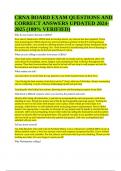
-
CRNA BOARD EXAM QUESTIONS AND CORRECT ANSWERS UPDATED 2024- 2025 (100% VERIFIED)
- Exam (elaborations) • 28 pages • 2024
-
- $17.49
- + learn more
CRNA BOARD EXAM QUESTIONS AND CORRECT ANSWERS UPDATED (100% VERIFIED) Why do you want to become a CRNA? Ever since I shadowed a CRNA back in nursing school, my interest has been sparked. I have been preparing for CRNA school ever since by getting a position in the ICU and learning as much as possible. I see myself as a lifelong learner as well as a sponge always needing to know the reason why behind everything I do. I look forward to transitioning that love of learning to this profession t...
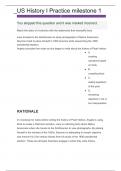
-
US History I Milestone 1.
- Exam (elaborations) • 29 pages • 2023
-
- $11.99
- + learn more
acres of free land to all who settled here. ● C. colonists included men, women, and children who did not intend to return to England RATIONALE Recall that the Jamestown Colony was established by the Virginia Company of London, a joint-stock company. Investors in the company hoped to find gold or silver, or other potentially valuable natural resources. As a result, most settlers to Jamestown were men and boys. On the other hand, Massachusetts was settled by Puritan families, including...
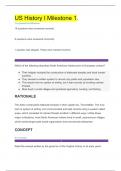
-
US History I Milestone 1.
- Exam (elaborations) • 20 pages • 2023
-
- $12.99
- + learn more
You passed this Milestone 16 questions were answered correctly. 8 questions were answered incorrectly. 1 question was skipped. These were marked incorrect. 1 Which of the following describes North American Indians prior to European contact? RATIONALE The Aztec constructed elaborate temples in their capital city, Tenochtitlán. The Inca had no system of writing, but communicated and kept records using a system called quipu, which consisted of colored threads knot...
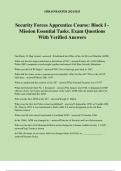
-
Security Forces Apprentice Course: Block I - Mission Essential Tasks. Exam Questions With Verified Answers
- Exam (elaborations) • 9 pages • 2024
-
- $10.49
- + learn more
Security Forces Apprentice Course: Block I - Mission Essential Tasks. Exam Questions With Verified Answers Gen Henry H. Hap Arnold - answer- Established the Office of the Air Provost Marshal (APM). What was the first major milestone in the history of SF? - answerArmy AF (AAF) Military Police (MP) companies were brought together and named AAF Base Security Battalions. What year did AF SF begin? - answer1947, but its heritege goes back to 1943. When did the Army create a separate provost ma...
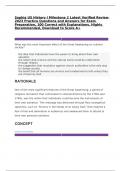
-
Sophia US History I Milestone 2 Latest Verified Review 2023 Practice Questions and Answers for Exam Preparation, 100 Correct with Explanations, Highly Recommended, Download to Score A+
- Exam (elaborations) • 18 pages • 2023
- Available in package deal
-
- $9.49
- + learn more
Sophia US History I Milestone 2 Latest Verified Review 2023 Practice Questions and Answers for Exam Preparation, 100 Correct with Explanations, Highly Recommended, Download to Score A+ 1 What was the most important effect of the Great Awakening on colonial society? RATIONALE One of the most significant features of the Great Awakening, a period of religious revivalism that culminated in colonial America by the 1730s and 1740s, was the notion that individuals could become the instru...
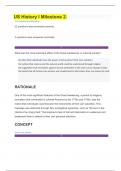
-
US History I Milestone 2.
- Exam (elaborations) • 18 pages • 2024
-
- $13.09
- + learn more
US History I Milestone 2. You passed this Milestone 22 questions were answered correctly. 3 questions were answered incorrectly. 1 What was the most important effect of the Great Awakening on colonial society? RATIONALE One of the most significant features of the Great Awakening, a period of religious revivalism that culminated in colonial America by the 1730s and 1740s, was the notion that individuals could become the instruments of their own salvation. This messag...
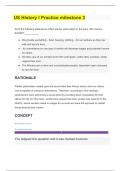
-
US History I Practice milestone 3
- Exam (elaborations) • 25 pages • 2024
-
- $11.98
- + learn more
US History I Practice milestone 3 All of the following statements reflect planter paternalism in the early 19th century, EXCEPT . RATIONALE Planter paternalism rested upon the racist belief that African slaves were an inferior race incapable of caring for themselves. Therefore, according to this ideology, slaveowners were performing a social good by providing basic necessities for their slaves for life. On this basis, southerners argued that their society was superior to the Nort...
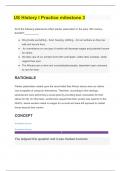
-
US History I Practice milestone 3
- Exam (elaborations) • 25 pages • 2024
-
- $12.49
- + learn more
US History I Practice milestone 3 All of the following statements reflect planter paternalism in the early 19th century, EXCEPT . RATIONALE Planter paternalism rested upon the racist belief that African slaves were an inferior race incapable of caring for themselves. Therefore, according to this ideology, slaveowners were performing a social good by providing basic necessities for their slaves for life. On this basis, southerners argued that their society was superior to the Nort...
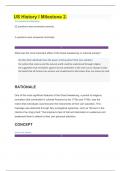
-
US History I Milestone 2.
- Exam (elaborations) • 18 pages • 2023
-
- $18.39
- + learn more
US History I Milestone 2. You passed this Milestone 22 questions were answered correctly. 3 questions were answered incorrectly. 1 What was the most important effect of the Great Awakening on colonial society? RATIONALE One of the most significant features of the Great Awakening, a period of religious revivalism that culminated in colonial America by the 1730s and 1740s, was the notion that individuals could become the instruments of their own salvation. This messag...
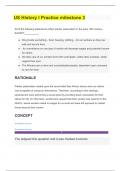
-
US History I Practice milestone 3
- Exam (elaborations) • 25 pages • 2023
-
- $19.28
- + learn more
US History I Practice milestone 3 All of the following statements reflect planter paternalism in the early 19th century, EXCEPT . RATIONALE Planter paternalism rested upon the racist belief that African slaves were an inferior race incapable of caring for themselves. Therefore, according to this ideology, slaveowners were performing a social good by providing basic necessities for their slaves for life. On this basis, southerners argued that their society was superior to the Nort...

How did he do that? By selling his study resources on Stuvia. Try it yourself! Discover all about earning on Stuvia


